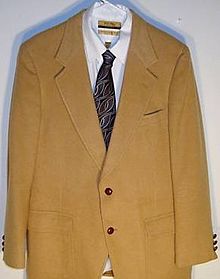Bill Blass
Bill Blass | |
|---|---|
 | |
| Born | June 22, 1922 |
| Died | June 12, 2002(aged 79) |
| Nationality | American |
| Education | Parsons School of Design |
| Label | Bill Blass Limited |
| Awards | Coty Award seven times;[1] Fashion Institute of Technology Lifetime Achievement Award, 1999[1] |
William Ralph "Bill" Blass (June 22, 1922 – June 12, 2002) was an American fashion designer, born in Fort Wayne, Indiana.[1] He is known for his tailoring and his innovative combinations of textures and patterns.[1] He is the recipient of many fashion awards, including seven Coty Awards and the Fashion Institute of Technology's Lifetime Achievement Award (1999).[1]
Early life
Bill Blass, born William Ralph Blass in 1922, was the only son of Ralph Aldrich Blass, a traveling hardware salesman who committed suicide when his son was five years old, and his wife, the former Ethyl Easter Keyser (died 1952), a dressmaker. He had one sister, Virginia Mae (born 1920).
In his autobiography Blass wrote that the margins in his school books were filled with sketches of Hollywood-inspired fashions instead of notes. At fifteen, he began sewing, selling evening gowns for $25 each to a New York manufacturer. At 17 he had saved up enough money to move to Manhattan and study fashion. He excelled in his fashion studies immediately and at 18 was the first male to win Mademoiselle's Design for Living award. He spent his salary of $30 a week on clothing, shoes, and elegant meals.
In 1942 Blass enlisted in the army. He was assigned to the 603rd Camouflage Battalion with a group of writers, artists, sound engineers, theater technicians, and other creative professionals. Their mission was to fool the German Army into believing the Allies were positioned in fake locations. They did this by using recordings, dummy tanks, and other false materials.
Fashion career

Blass began his New York fashion career in 1946.[1] He was a protégé of Baron de Gunzburg.[2] In 1970, after two decades of success in menswear and womenswear, he bought Maurice Rentner Ltd., which he had joined in 1959, and renamed it Bill Blass Limited.[1] Over the next 30 years he expanded his line to include swimwear, furs, luggage, perfume, and chocolate. By 1998, his company had grown to a $700-million-a-year business.
Blass’ designs are best known for being wearable. In a time when other designers were designing clothes which were known more for being a work of art, Blass was designing clothing which even everyday women could wear day or night. According to Ellin Saltzman in the New York Times, "He took American sportswear to its highest level…giving it a clean, modern, impeccable style… He, probably more than any designer knew his customer and understood her."
The Bill Blass Edition Continental Mark series
Beginning in 1976, and continuing until 1992, Blass lent his talents to the Ford Motor Company for an exclusive edition of their Continental Mark series of automobiles. In 1976 he shared model configurations with Emilio Pucci, Hubert de Givenchy, and Cartier. Each year, as goes true fashion, the interior and exterior color combinations would be updated. One of the most popular was the 1979 edition honoring a nautical theme, as did the Blass logo of the time. Small anchors were incorporated into the exterior accent striping and interior accents within the Blass back-to-back "B" design theme. A truly unique feature of this model, and the 1980 through 1983 Mark series Blass models, was a "carriage roof" giving a convertible top look to the cars. After 1983, the Blass edition became just a unique color option with rear quarter window model designations and a few features that were options on the standard model.
Tyler Rose was assistant designer for William Blass.
Retirement and death
In 1999 Blass sold Bill Blass Limited for $50 million to Michael Groveman and retired to his home in New Preston, Connecticut. Blass was diagnosed with oral/tongue cancer in 2000,[3] not long after he began writing his memoir.[4] His cancer later morphed into throat cancer, resulting in Blass's death in 2002.[3] He died ten days before his 80th birthday and six days after completing his memoir, "Bare Blass".
Blass collected art and was a connoisseur of antiquities and in his will bequeathed half of his $52 million estate, as well as several important ancient sculptures, to the Metropolitan Museum of Art.[5][6]
Publications
- Dining in Manhattan Cookbook: A Collection of Gourmet Recipes for Complete Meals from Manhattan's Finest Restaurants, with Joan G. Hauser (1983)
- Bare Blass, edited by Cathy Horyn (2002)
See also
References
- ^ a b c d e f g Bill Blass Biography - Biography.com
- ^ Dupont, Ronald J, Jr. (1991). "Baron Nicolas de Gunzburg". The Vernon Stories of Jacobus Van Brug. Retrieved 9 July 2006.
{{cite web}}: CS1 maint: multiple names: authors list (link) - ^ a b Bill Blass
- ^ Bare glass book review from Look Online.
- ^ Mead, Rebecca (2007-04-09). "Den of Antiquity: the Met Defends its Treasures". The New Yorker: 54–61.
- ^ http://www.metmuseum.org/annual_report/2005_2006/pdf/03report-from-director06.pdf
